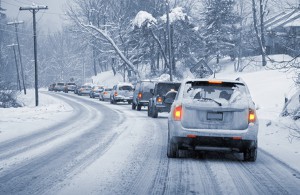
U.S. drivers pay nearly $500 for each vehicle due to the affect of road salt and de-icers. Photo credit: AAA.
Winter storms have created havoc across the U.S. this year, causing travel delays, carnage on the roadways and an expected $3 billion will be spent by drivers to fix rust damage caused by road salt and other de-icing solutions.
According to AAA, drivers spent $15.4 billion during the last five years to repair the damage these answers to snowy and icy roads do to American vehicles. It averages $490 per vehicle.
In case you believe you are immune this is “phenomenon,” note that more than 150 million vehicles drive on roads affected by winter weather.
“While the application of de-icing salts and solutions is critical to keeping our nation’s roadways safe every winter, it’s important that drivers pay attention to warning signs that their vehicle may be suffering from rust-related damage,” said John Nielsen, AAA’s managing director of Automotive Engineering and Repair.
(The 1% mostly likely drives the same vehicle everyone else does. Click Here to find out what it is.)
“This can be much more than a cosmetic issue, it can also create serious safety issues for drivers by impacting brake lines, exhaust systems, fuel tanks and electrical connections.”
Road salt and other de-icing methods can affect brake lines, fuel lines and exhaust. AAA recommends that drivers immediately have their car serviced if warning lights come on, the scent of fuel or exhaust is present, or the brake pedal becomes soft.
Many drivers are reminded about road salt each time they see a rusty wreck roll down the road. However, many state and local transportation departments have shifted from using rock salt to liquid de-icers to combat ice and snow on the roadways.
These newer alternatives are more effective than traditional salt because they can be applied before a snowstorm, have a lower freezing point and melt ice and snow faster. However, these same characteristics can be even more damaging to vehicles since the chemicals remain in liquid form longer and are more likely to coat components and seep into cracks and crevices where corrosion can accelerate.
(Click Here for more about 2016 auto sales.)
“In the last five years, 22 million U.S. drivers have experienced rust damage to their cars due to salt and liquid de-icers,” said Nielsen in a statement. “In addition to the safety risk, repairs to fix these problems are often costly, averaging almost $500 per occurrence.”
AAA has a few suggestions for lessening the impact of these things on your vehicle:
- Keep the stuff off: wash and wax your vehicle before winter starts
- Wash your vehicle often during the winter months, especially the underside
- Try to stay off the roads during the times that salt and de-icers are applied
- Touch up any paint chips on the body of your vehicle, covering exposed metal
While road salt and the like is a big winter problem for vehicles, it’s not the only winter problem that can impact your vehicle. The freezing and thawing of roadways can create the potholes.
(Congestion costing drivers $1,200 annually. Click Here for the story.)
Pothole damage is another concern for drivers, as snow and ice melt and roadways begin to crumble. A new AAA survey found that nearly 30 million U.S. drivers experienced pothole damage significant enough to require repair in 2016, with repair bills ranging from under $250 to more than $1,000.
